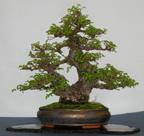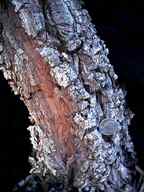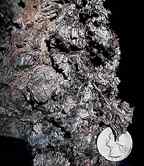
| Articles | Home Page | Images | Order Form | Plant Catalog |
Ulmus parvifolia (Chinese Elm) S\M\-10ø\RG\Ls\B Deciduous (semi-evergreen) trees. We grow dwarf and ornamental Chinese Elms mainly for bonsai, however they can also make nice small landscape trees if staked until they can support their branches which may take 5-10 years. These are all trouble free, easy to grow trees. They prefer full sun and well drained soil. Brown scale may be a problem in some areas, but is easily treated. The small leaves and corky bark (of some cultivars) are very attractive. The real beauty of these trees is their performance in a bonsai pot or other container after trunk development. They can quickly achieve a 3 inch or greater trunk in about 5 years with deeply fissured corky bark when planted in the ground. They are easily top and root pruned and respond dramatically to root bound conditions where leaf size and node spacing is reduced to one half inch or less. They should be repotted every 2-3 years. A Seiju Elm field grown for 5 years will easily develop a 4 inch trunk and may be spring dug and placed immediately into a bonsai pot with spectacular results. Cutting grown plants. All of these elms are resistant to Dutch Elm Disease.
9600 Ulmus parvifolia 'Catlin' Very shiny 1
1/2 inch green leaves that will reduce to less than one inch. Smooth gray
bark that slightly roughens and flakes with great age just like the
species. Nice horizontal branching. Evergreen to about 20ø. If grown out
may reach 15 feet. One of the very best elms for small bonsai due to the
nice twiggy branching and small deep green leaves. Slow to form a larger
trunk, but can make a nice forest planting.
2 3/4 INCH POTS $18
FOUR INCH POTS SIZE $27
ONE GALLON SIZE $55 Available June 2025
| 9605 Ulmus parvifolia 'Catlin Contorted' A
fantastically congested sport of 'Catlin'. In older plants the
nodes are stacked up to 15 per inch. The leaves are the same shiny
green but are only 1/2inch. 10 year old plants are 12-18 inches
tall (bottom photo). The stems are slightly contorted. Very rare.
Due to the extremely slow growth our 2 3/4 inch pot size plants
will only be about 2 inches tall. The picture is a ten year old
plant taken in winter. It is approximately one foot tall. We have
been having a great deal of difficulty getting these plants to a
saleable size and getting these to a larger size can be tricky. HERE is a link to the special care
sheet for this cultivar. The top photo is representative of the
plants in 2 3/4 inch pots. 2 3/4 INCH POTS $40 |

 |
| 9610 Ulmus parvifolia 'Corticosa' (Corkbark
Chinese Elm) Large 1 1/2 to 2 inch, light green leaves that reduce
nicely. Bright yellow fall color. Corky bark begins to appear at
8-10 years and is gray. Full size may be 15-20 feet. Fast growing,
tough. Pictured is the bark of a ten year old tree that has been
field grown. Note the quarter in the lower right quadrant for
reference (click the picture to enlarge). This cultivar is better
for larger bonsai where its leaves will be in scale and the bark
will have a chance to fully mature. FOUR INCH POTS $27 SIX INCH POTS $45 Available June 2025 ONE GALLON SIZE $55 SPECIMEN CATALOG |
 |
| 9650 Ulmus parvifolia 'Seiju' This
sport of 'Hokkaido' was introduced by Carl
Young of Lodi California. It has all the good qualities of 'Hokkaido'
in a larger plant. The leaves (lower picture) are
identical except they are about 1/2 inch and the plant may reach
about 10 feet if planted out. It has the same deeply fissured
corky/warty bark (upper picture) that begins roughening in about 2
years. The wood is stronger and more flexible and can be wired.
Grows quickly, about 18 inches a year. This cultivar is best for
Shohin through medium sized bonsai. It should be large enough to
allow the bark to fully develop, but also can be grown to six inch
caliper is a reasonable amount of time. 2 3/4 INCH POTS $18 Sorry, Sold Out FOUR INCH POTS $27 Available June 2025 ONE GALLON SIZE $55 SPECIMEN CATALOG |

|
9670 Ulmus parvifolia 'Fuiri' 1 to 1 1/2 inch
variegated leaves that are light green thinly edged with silver frosting.
New leaves are very pale lime green and silvery and retain this look until
late spring when they turn darker green retaining their thin silvery edge.
Bark is smooth gray roughening slightly with great age. Slower than the
cork types to trunk up due to the lack of the cork adding to the caliper
but growing about as fast as the species. This plant can also make a very
handsome landscape plant. Probable ultimate height is 30 feet. One of the
very nicest elm bonsai in our nursery is Ulmus p. 'Fuiri'. The leaves
reduce nicely and it gets very twiggy. The silver edging on the leaves is
not very noticeable, but the lime green new growth is stunning. Bud break
is prolific in spring, even on very old wood.
FOUR INCH POTS $27
ONE GALLON SIZE $55
9680 Ulmus parvifolia 'Yatsubusa' Another
Carl Young introduction (see 'Seiju' above) with very
interesting elongated medium green leaves to 1 1/2 inches. It has the
corky bark similar to 'Seiju' but takes a little longer
to develop, but it grows a little faster. Ultimate height is perhaps 8-10
feet.
FOUR INCH POTS $27 Available
June 2025
ONE GALLON SIZE $55
Wisteria S\M\-30\RG\Ls\B Deciduous woody vines. Probably the most popular flowering vine, with long pendulous racemes of fragrant flowers from pure white to deep purple. Needs full sun, but not picky about soil conditions. Do not fertilize established plants as excess nitrogen can interfere with bloom (except for bonsai).
Seedlings are slow to flower, sometimes taking seven years or more. Plants for landscape and bonsai use should be either cutting grown or grafted to ensure ability to flower well and in the desired color.Cutting grown plants are hard to find and take longer to establish a good root crown and tapered trunk, but will not have visible graft unions.
Young plants should be allowed to grow freely to establish a structure after which new growth and streamers should be continually removed to control the shape and size. This is no mean task, therefore it is best to train Wisteria in a fashion that can be easily reached with hand pruners. Flowers are borne on spurs (short stubby side growth packed with buds) that should not be disturbed.
The two most common species are W. sinensis or Chinese Wisteria, that blooms in early spring before the foliage emerges making a spectacular flower display, and W. floribunda or Japanese Wisteria which blooms in April to May after the foliage has appeared. All colors are available in either species.
We have been having propagation problems growing these from cuttings and hope to have more in 2023
| Articles | Home Page | Images | Order Form | Plant Catalog |